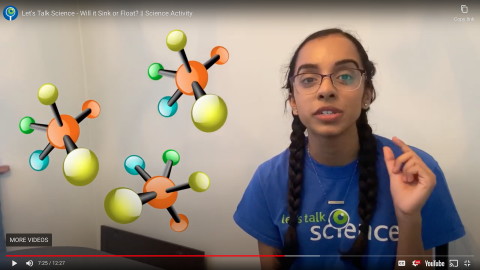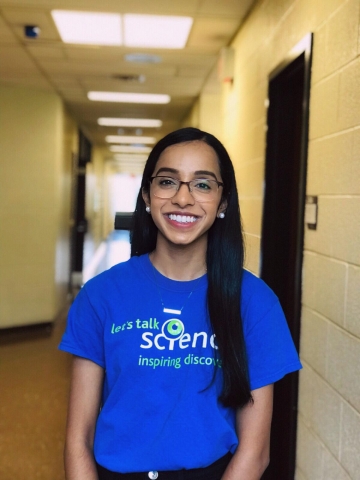STEM Role Model Inspires Inner-City Youth
Shalini Iyer knows that for some students, the most meaningful lessons and inspiration can happen outside school. When Iyer prepares science activities for young people in Toronto’s Jane-Finch area, she is doing more than offering a fun after-school program. She is serving as a role model.
“I really connected with the students when we met in-person,” says Iyer. “They said ‘I want to be a scientist like you.’ Growing up, I didn’t have that.”
Iyer is a university student and Let Talk Science volunteer, who worked as a program assistant with the San Romanoway Revitalization Association (SRRA) last year.
SRRA is a social service organization that aims to create a safer and healthier environment for children and youth in the community. That happens through breakfast and after-school programs, including activities to enhance the learning skills needed for long-term success in school and life. These programs take place at a community centre in the San Romanoway neighbourhood - located in the broader Jane-Finch community of Toronto, Ontario.
The kids who take part are diverse. Like many of the kids she worked with at the Centre, Iyer is a person of colour. When she was their age, she didn’t see many people who looked like her in certain careers.
“Having that representation can really make an impact,” says Iyer. In December 2019, she finished an undergraduate degree in biomedical science and psychology at York University. In September 2020, Iyer is starting a Master’s in Neuroscience at York, and will be researching brain development and the relationship to autism spectrum disorders.
The Let’s Talk Science and SRRA partnership began in 2017 thanks to the relationship and financial support of the Gordon & Ruth Gooder Charitable Foundation. Let’s Talk Science started to work with SRRA, to bring engaging STEM-based learning to youth who wouldn’t typically have access to a scientist in a classroom. Iyer didn’t have access to scientific role models when she was growing up, in a similar community nearby.
“One or two teachers did cool science experiments,” she says. That was it. Her community, the one SRRA serves and others like it can be challenged with resources. They’re less affluent, and many of the kids are labelled marginalized MVP (most vulnerable youth). “It’s great that Let’s Talk Science is visiting these areas,” says Iyer.
Learning changed perceptions
Let’s Talk Science aims to expose all children and youth to hands-on STEM learning. The experiences at SRRA are designed to change youths' perception of science.
“We teach them that science is everywhere, applied in real life, and is something to look forward to outside school as well,” says Iyer.
As a program assistant, Iyer helped with the after-school program three times a week, with each group including Kindergarten to Grade 3, Grades 4-6, and Grades 6-8. Activities ranged from coding using micro:bits, to making fossils, to building a catapult. Faculty of Education students at York worked alongside Iyer, as one of their placements, to help deliver the engaging content.
When the world began to shut-down, all in-person sessions were paused and Let’s Talk Science delivered STEM activity workbooks and supplies for the kids to use at home. This activity inspired the Horizon Project. The kids were so excited to get them, says Iyer, and some even asked for more than one.
To continue students’ learning, Let’s Talk Science began bringing STEM learning to SRRA remotely via Zoom. “We transformed our existing outreach to do it virtually,” she says.
Iyer says these opportunities deepen students’ understanding of science and helps them see it in the world around them. For instance, when Iyer started, she would ask questions like "Does art involve science?" Students would respond no in the beginning. She would point out things like how paint mixes or sticks to paper. Workshops catered to the children’s interests, like art and sports, or making computer games. After continued visits and near the end of the year, she asked the same question and the students would respond, yes and be able to explain why.
Their learning also appears to have continued at home with parents/caregivers, helping to reinforce STEM concepts introduced through the program.
Program dispelled stereotypes
At first, some children accepted that science is everywhere but couldn’t describe that in detail. As the after-school program went on, more and more they could see the interconnectedness of science with every aspect of their life. That’s part of being able to connect a range of careers to STEM.
Can they see their own possible future in it? When asked to draw a scientist, SRRA participants now frequently depict persons of colour and an equal mix of male and female figures. That shows how the program has dispelled some stereotypes associated with a job in STEM.
When asked who they know in science, the majority of the children also respond with “Let’s Talk Science” and the names of Let’s Talk Science staff and volunteers. It’s clear that Let’s Talk Science has had a positive influence on the children’s connection to science and also highlights the importance of having role models in STEM.
Iyer recalls one middle school student trying to work out an engineering challenge. This student was hesitant to jump in, perhaps because she was one of the few girls amidst all the boys. She eventually found her voice and started to ask Iyer how to become a scientist, what would she have to do in high school to set her on the right learning path.
“She just needed that confidence, that boost, that person who felt her ideas were good,” says Iyer.
Working with the SRRA affected Iyer too. She wanted to give back to the community and inspire students to take on a path similar to hers. What she found was that she gained “valuable experiences and skills that I will carry with me as I continue to pursue my career as a scientist.”
Building relationships with the students and coming up with strategies to keep them engaged has been hugely beneficial to Iyer.
“It provided me the opportunity to think critically and outside the box,” she says. “Being able to develop creative projects and innovatively solve problems is a critical skill used on a day-to-day basis as a researcher. Being a researcher, it is very easy to get lost in scientific jargon. Working as a program assistant strengthened my decomposition and communications skills, being able to break down complex scientific concepts for various audiences.”
What’s most gratifying to Iyer is the enthusiasm shown by the students and the idea that she may have ignited a spark.
“There wasn’t a week where the students wouldn’t eagerly approach me and ask, ‘Is it Let’s Talk Science day? What are we doing? While peering into my bags to get a glimpse of the science activity, excitement in their eyes. I hope I was able to touch the hearts of the SRRA students and give them a memorable educational experience.”
Thank you to our donors
The Let’s Talk Science and SRRA partnership began in 2017 thanks to the relationship and financial support of the Gordon & Ruth Gooder Charitable Foundation. Since 2017, through their generous support, Let’s Talk Science has provided year-round hands-on STEM learning for students in Grades K-8.
In 2019, the Aubrey & Marla Dan Foundation also began funding this important initiative as a way for Let’s Talk Science to increase its capacity to provide meaningful and positive experiences to not only SRRA, but Let’s Talk Science volunteers, the Program Assistant, SRRA staff and parents.

